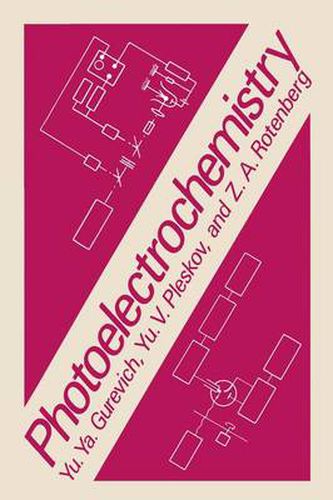Photoelectrochemistry

Photoelectrochemistry
This title is printed to order. This book may have been self-published. If so, we cannot guarantee the quality of the content. In the main most books will have gone through the editing process however some may not. We therefore suggest that you be aware of this before ordering this book. If in doubt check either the author or publisher’s details as we are unable to accept any returns unless they are faulty. Please contact us if you have any questions.
We enthusiastically welcome this opportunity to introduce this major work of Gurevich, Pleskov, and Rotenberg to English-speaking readers since photoelectrochemistry has, in recent years, become very significant for modern energy transfer and energy conversion phenomena. While having its roots in early electrochemistry, this field, in its modern aspects, has had an important impact on knowledge of the production and state of solvated electrons and on photoassisted electrolysis at semiconductors. Photoeffects resulting in electron emission into solution have also given rise to new ways of understanding double-layer structure and measuring potentials of zero charge. Electrochemical photoemission studies have added to and comple- mented the literature of solvated electron chemistry arising from experiments with high-energy radiation. The authors’ treatment of photoelectron emission phenomena at metal/ solution interfaces is thorough and quantitative and, we believe, will con- stitute a landmark in the development of this fundamentally interesting and practically important area of electrochemistry and photophysics. H. Wroblowa B. E. Conway v Foreword A characteristic feature of modern electrochemistry is the continually broadening utilization of nontraditional methods and development of new directions of research. A number of such approaches are based on illumina- tion techniques. First, irradiation is used in electrochemistry mainly as a research tool. Mention should be made here of methods such as electro- reflection, ellipsometry, internal reflection spectroscopy, interferometry of surface layers, and other techniques firmly established in experimental electrochemistry. Second, light directly affects electrode processes. In- vestigation of the latter phenomenon is the subject of photoelectrochemistry.
This item is not currently in-stock. It can be ordered online and is expected to ship in 7-14 days
Our stock data is updated periodically, and availability may change throughout the day for in-demand items. Please call the relevant shop for the most current stock information. Prices are subject to change without notice.
Sign in or become a Readings Member to add this title to a wishlist.


